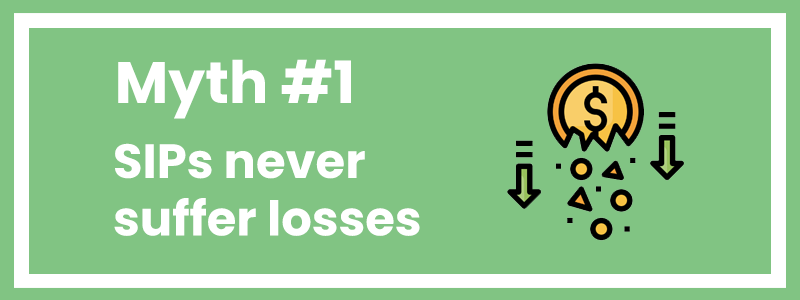One of the most readily available investment options for investors is a systematic investment plan (SIP). However, with investors contributing more each year, there are many SIP myths, just like everything that is widely accepted.
Here are the top seven fallacies about investing in mutual funds through systematic investment plans:

A SIP can indeed lower the risk factor and protect against abrupt market declines. Yet, they are still susceptible to market declines. That means SIPs might not protect you from all kinds of losses, and occasionally, especially when markets fall, your investment value might even go down.
So, why do all financial gurus revere SIPs? It is so because you can average the cost of purchases over time, thanks to SIPs. As a result, a market collapse would have a less drastic effect.

Returns on SIP investments are never guaranteed. Investing, be it in equity-oriented MFs, always involves particular risks in which you might not only not see returns, but even suffer a considerable loss.
If you wait for your investment to mature in debt funds, your SIP investments will be more predictable. But prematurely withdrawing from a debt fund investment exposes you to interest rate fluctuations (in simpler words, unpredictability in returns).

By continually investing in stock, you can average your investment costs and better withstand market ups and downs. However, a recent idea known as smart SIPs has carried this idea too far. Some suggest that increasing the number of SIPs will boost returns. They believe that choosing SIPs that are made fortnightly, weekly, or even daily is preferable to the dull monthly choice.
All this is unneeded excess and adds extra challenges to maintaining or keeping track of your money. Besides causing additional operational difficulty, increasing your SIP frequency has no discernible impact on your returns. A monthly SIP is the simplest way to profit from market fluctuations while keeping track of the paperwork.

Because a SIP enables you to start investing for as little as $5-10 each month, many people believe it is only for small investors. But that is merely the bare minimum.
The maximum SIP amount is not capped for the vast majority of mutual funds. As a result, you are free to invest as much as you like – a fact that SIP demonstrates that this investment option is appropriate for all investors, big and small.

You can miss a SIP installment by one or two months, but it is generally advised against. You do not have to pay a fine, and your investment will not become inactive. But be mindful that banks might charge you if you fail to honor auto-debit payments.
If you skip investing for three consecutive months, however, there is a chance that your SIP investment will be canceled. In this situation, you will need to submit a new mandate in order to resume your SIP.

Another common but wrong belief is that you cannot change the details of your SIP once started, such as the amount or tenure. You have a lot of flexibility with SIPs, in fact. The investment amount and term are always flexible. If your income changes or if you decide to increase your investment, you can change the SIP amount. You can ask even the fund house to stop your SIPs.
You also have the option of changing mutual funds.

You are free to use a SIP for both equity or non-equity funds if it makes sense for you. Many investors find that a SIP aids in preventing you from wasting money on pointless materialistic items and instills in you a disciplined approach to investing and saving money.
SIP Investment, in a nutshell
The SIP investment method for mutual funds enables investors to average their cost of investments. In addition, it aids in forming the habit of investing because a percentage of your salary is taken out of your account each month and invested. As a result, it fits in well with your monthly financial cycle, in which you earn, spend, and invest.







